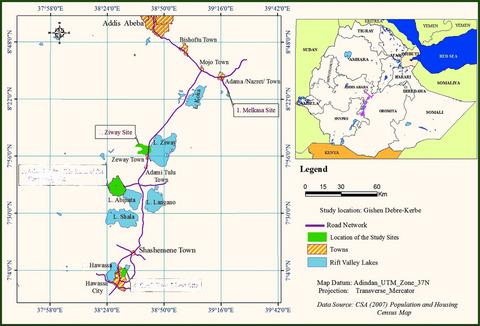当前位置:
X-MOL 学术
›
Food Energy Secur.
›
论文详情
Our official English website, www.x-mol.net, welcomes your
feedback! (Note: you will need to create a separate account there.)
On‐farm seed priming and fertilizer micro‐dosing: Agronomic and economic responses of maize in semi‐arid Ethiopia
Food and Energy Security ( IF 4.0 ) Pub Date : 2019-11-11 , DOI: 10.1002/fes3.190 Getachew Sime 1, 2 , Jens B. Aune 2
Food and Energy Security ( IF 4.0 ) Pub Date : 2019-11-11 , DOI: 10.1002/fes3.190 Getachew Sime 1, 2 , Jens B. Aune 2
Affiliation

|
On‐farm seed priming has been reported to improve emergence, crop establishment, and yield besides improving economic benefits in dryland agriculture. These benefits can further be improved by fertilizer micro‐dosing. The purpose of this study was to investigate the effect of on‐farm seed priming and fertilizer micro‐dosing on the agronomic and economic returns of maize (Zea mays L. var. Melkassa‐2) in semi‐arid agro‐ecological conditions in Ethiopia. The experiments consisted of four treatments: no priming and no fertilizer; no priming and fertilizer; priming and no fertilizer; and priming and fertilizer. The experiments were conducted in three locations viz., Melkassa, Ziway, and Hawassa in the central Rift Valley. Analysis of variance for each location was performed separately at p ˂ .05. Results of each location were similar over the experimentation years, and hence, there was no need for carrying out combined analysis. Regardless of fertilization, primed plants showed faster emergence; better uniform crop stands; more vigorous plants; earlier flowering; earlier harvest; and higher grain and stover yield than no primed plants. Germination was 2–3 days earlier, and flowering and maturation of primed plants were 10 to 13 days earlier than no primed plants. Average grain yield increased by 11, 8, and 6% in Melkassa, Ziway, and Hawassa, respectively, by priming over no priming. Fertilizer micro‐dosing combined with priming further improved most of the agronomic characters. Fertilizer micro‐dosing combined with priming increased the average grain yield by 75, 69, and 33% in Melkassa, Ziway, and Hawassa, respectively. The economic returns also increased in the same pattern as the agronomic responses for priming, micro‐dosing or their combination. To realize the potential of seed priming of increasing agronomic performances, future research and development efforts should focus on understanding the possible underling physiological and biochemical basis of this poorly understood process with the different priming techniques.
中文翻译:

农场种子灌育和肥料微剂量:埃塞俄比亚半干旱地区玉米的农艺和经济响应
据报导,在农场上播种种子不仅可以改善旱地农业的经济效益,而且可以改善出苗率,作物产量和单产。通过微剂量施用肥料可以进一步改善这些益处。这项研究的目的是研究埃塞俄比亚半干旱农业生态条件下,农场种子引发和微剂量施肥对玉米(Zea mays L. var。Melkassa-2)的农业经济效益的影响。 。实验由四种处理组成:不加底漆和不施肥;无底漆和肥料;底漆,不施肥;和底漆和肥料。实验在中部裂谷的三个地点进行,分别是梅尔卡萨(Melkassa),齐威(Ziway)和霍瓦萨(Hawassa)。每个位置的方差分析分别在p进行 ˂.05。在实验年中,每个位置的结果都相似,因此无需进行组合分析。不论施肥如何,发芽植物均显示出较快的萌芽。更好的均匀作物林;更有活力的植物;开花较早;较早收获;比没有底漆的植物,谷物和秸秆产量更高。发芽要比未发芽的植物提前2-3天,发芽植物的开花和成熟要早10-13天。通过不加注水处理,梅尔卡萨(Melkassa),齐威(Ziway)和霍瓦萨(Hawassa)的平均谷物产量分别增加了11、8和6%。肥料的微剂量加底肥进一步改善了大多数农艺性状。在Melkassa,Ziway和Hawassa,微剂量加底肥可将平均谷物产量分别提高75%,69%和33%。经济回报也以与对引发,微量给药或其组合的农艺反应相同的方式增长。为了实现潜在的提高农艺性能的种子引发的潜力,未来的研究和开发工作应着重于了解使用不同引发技术对这种鲜为人知的过程的潜在基础生理和生化基础。
更新日期:2019-11-11
中文翻译:

农场种子灌育和肥料微剂量:埃塞俄比亚半干旱地区玉米的农艺和经济响应
据报导,在农场上播种种子不仅可以改善旱地农业的经济效益,而且可以改善出苗率,作物产量和单产。通过微剂量施用肥料可以进一步改善这些益处。这项研究的目的是研究埃塞俄比亚半干旱农业生态条件下,农场种子引发和微剂量施肥对玉米(Zea mays L. var。Melkassa-2)的农业经济效益的影响。 。实验由四种处理组成:不加底漆和不施肥;无底漆和肥料;底漆,不施肥;和底漆和肥料。实验在中部裂谷的三个地点进行,分别是梅尔卡萨(Melkassa),齐威(Ziway)和霍瓦萨(Hawassa)。每个位置的方差分析分别在p进行 ˂.05。在实验年中,每个位置的结果都相似,因此无需进行组合分析。不论施肥如何,发芽植物均显示出较快的萌芽。更好的均匀作物林;更有活力的植物;开花较早;较早收获;比没有底漆的植物,谷物和秸秆产量更高。发芽要比未发芽的植物提前2-3天,发芽植物的开花和成熟要早10-13天。通过不加注水处理,梅尔卡萨(Melkassa),齐威(Ziway)和霍瓦萨(Hawassa)的平均谷物产量分别增加了11、8和6%。肥料的微剂量加底肥进一步改善了大多数农艺性状。在Melkassa,Ziway和Hawassa,微剂量加底肥可将平均谷物产量分别提高75%,69%和33%。经济回报也以与对引发,微量给药或其组合的农艺反应相同的方式增长。为了实现潜在的提高农艺性能的种子引发的潜力,未来的研究和开发工作应着重于了解使用不同引发技术对这种鲜为人知的过程的潜在基础生理和生化基础。











































 京公网安备 11010802027423号
京公网安备 11010802027423号